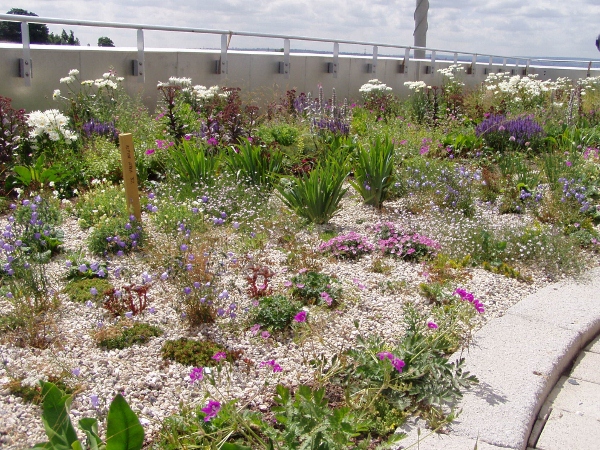- Delivering SuDS
- Using SuDS
- Background
- SuDS principles
- Benefits of SuDS
- Benefits of SuDS
- Why developers should choose SuDS
- Flood risk management
- Water quality management
- Biodiversity & ecology
- Amenity
- Air quality
- Building temperature
- Carbon reduction and sequestration
- Crime
- Economic growth
- Enabling development
- Flexible infrastructure/climate change adaptation
- Education
- Groundwater recharge
- Health and well being
- Pumping wastewater
- Rainwater harvesting
- Recreation
- Tourism
- Traffic calming
- Treating wastewater
- SuDS components
- SuDS components overview
- Source control
- Swales & conveyance channels
- Filtration
- Infiltration
- Retention & detention
- Wetlands
- Inlets, outlets and control structures
- SuDS performance & monitoring
- Delivery
- The costs & benefits of SuDS
- Adoption & maintenance of SuDS
- Legislation & regulation
- Design guidance
- Retrofitting SuDS
- Drainage exceedance
Component: Green roofs

Description
Green roofs comprise a multi-layered system that covers the roof of a building or podium structure with vegetation cover/landscaping. The roof is likely to consist of an impermeable layer, a susbstrate or growing medium and a drainage layer (although not all green roofs require a drainage layer).
Green roofs are designed to intercept and retain precipitation, reducing the volume of runoff and attenuating peak flows.
Advantages and disadvantages
|
Advantages |
|
|
Disadvantages |
|
Where component can be used?
Residential: Yes
Commercial/industrial: Yes
High density: Yes
Retrofit: Yes
Contaminated sites: Yes
Sites above vulnerable groundwater: Yes
Performance
Peak flow reduction: Medium
Volume reduction: Medium
Water quality treatment: Good
Amenity potential: Good
Ecology potential: Good
Maintainence
-
Irrigation is needed during establishment of vegetation for some roofs
-
Inspection for bare patches and replacement of plants will be required on a regular basis
-
Litter removal may be required (depending on setting and use)
Read more on:



